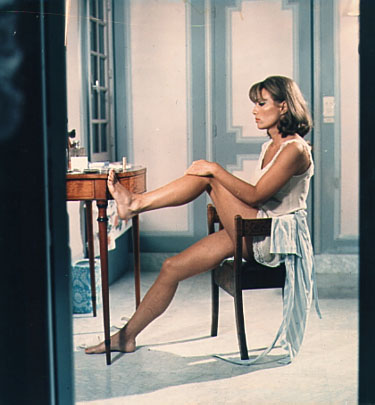
Anicée Alvina in Glissements progressifs du plaisir (1974)
Alain Robbe-Grillet‘s 1974 Glissements progressifs du plaisir… breaks numerous aesthetic and cultural boundaries and is not an easy film to watch as I found out during a mid 1970’s screening in Manhattan, with Robbe-Grillet in attendance, where I suddenly found myself so repulsed by the film’s transgressive imagery and atmosphere that I had to suddenly bolt the theater for fresh air. In the lobby I found myself faced with Robbe-Grillet himself, who was awaiting the post-movie discussion. He smiled as our eyes met for a second. I wanted to apologize or explain, but I didn’t say anything. He seemed to understand and proved to be a very modest and witty commentator on his own work. —Robert Monell
Anicée Alvina died last November. She was 52.

Anicée Alvina est morte le vendredi 10 novembre 2006, à l’âge de cinquante-deux ans, a-t-on appris hier. Comédienne par passion, plus caméléon que carriériste, « plutôt du genre rock’n’roll », selon ses propres termes, Anicée Alvina, l’égérie d’Alain Robbe-Grillet et de Gérard Blain, avait réussi à mener un parcours exigeant et multiple, passant même un moment à la chanson et à la scène au sein du groupe de rock Ici Paris. –via Le coin du cinéphage
Staying with Alain Robbe-Grillet, I just found a very interesting interview with him:
A.R.-G. Quand on [Alain and Catherine] s’est mariés j’étais pour la fidélité conjugale et c’est elle, tout de suite, qui m’a expliqué que c’était une idée assez sotte et probablement peu viable, que les messieurs avaient besoin de chair fraîche, et les dames aussi. Que ce qu’il fallait, c’était s’entendre bien. Le premier livre de Catherine, L’Image, écrit en 1957 peu avant notre mariage, endossait mes fantasmes sado-érotiques de la même façon que le livre de Dominique Aury, Histoire d’O, décrit, en réalité, ceux de Jean Paulhan. Peu à peu, Catherine a découvert qu’elle aimait inverser le fantasme et même, maintenant, se spécialiser dans la domination. Elle est une dominatrice passionnelle, le contraire d’une professionnelle, il n’est jamais question d’argent et comme c’est assez rare, sa cour est très étendue. —lire.fr








